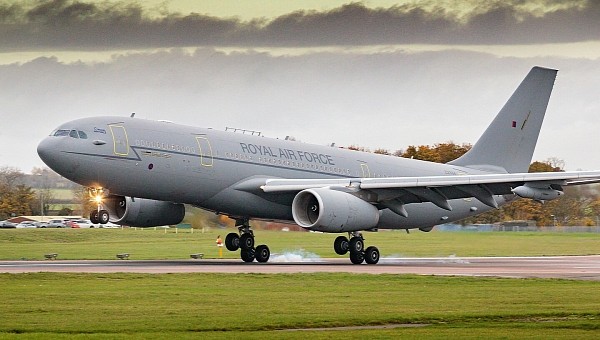It will be a while before fully-electric and hydrogen-electric aircraft can replace those in current commercial and military fleets. Until then, the alternative known as SAF (Sustainable Aviation Fuel) is considered the most practical solution that can be implemented without delay. In the military field, UK’s Royal Air Force (RAF) just hit a milestone, successfully completing the first SAF-powered flight of an in-service aircraft.
Airbus and Rolls-Royce played a major role in this historic endeavor, as the aircraft that carried out the flight is an Airbus A330 MRT (the military variant of the A330 commercial jetliner) equipped with Rolls-Royce Trent 700 engines.
SAF producer Air bp, British aircraft leasing company AirTanker, and the UK Ministry of Defense’s Defense Equipment and Support agency were also part of the complex project.
Together, they were responsible for the first flight of an in-service military aircraft powered only by SAF. Plus, it was the first 100% SAF flight of any type of aircraft carried out in the UK airspace.
The historic flight took place last week when a RAF Voyager conducted a 90-minute return flight from RAF Brize Norton. What made it unique is that, unlike previous tests, the Voyager had SAF in both engines, and not a single drop of conventional fuel. The flight-test crew was comprised of specialists from Airbus, Rolls-Royce, and RAF, with senior RAF officials and industry players attending. According to Airbus, the flight replicated an air-to-air refueling sortie.
The good news was that no differences were observed between the use of SAF and the use of conventional aviation fuel, known as JET1, in terms of operational efficiency. In other words, the heavy-duty Voyager (both a cargo aircraft and a refueling tanker) worked just as fine on fuel made from used cooking oil as it does on fossil fuel.
In addition to cutting CO2 emissions by 80% throughout the lifecycle, SAF is supposed to help RAF by making it less dependent on global supply chains in the future.
SAF producer Air bp, British aircraft leasing company AirTanker, and the UK Ministry of Defense’s Defense Equipment and Support agency were also part of the complex project.
Together, they were responsible for the first flight of an in-service military aircraft powered only by SAF. Plus, it was the first 100% SAF flight of any type of aircraft carried out in the UK airspace.
The historic flight took place last week when a RAF Voyager conducted a 90-minute return flight from RAF Brize Norton. What made it unique is that, unlike previous tests, the Voyager had SAF in both engines, and not a single drop of conventional fuel. The flight-test crew was comprised of specialists from Airbus, Rolls-Royce, and RAF, with senior RAF officials and industry players attending. According to Airbus, the flight replicated an air-to-air refueling sortie.
The good news was that no differences were observed between the use of SAF and the use of conventional aviation fuel, known as JET1, in terms of operational efficiency. In other words, the heavy-duty Voyager (both a cargo aircraft and a refueling tanker) worked just as fine on fuel made from used cooking oil as it does on fossil fuel.
In addition to cutting CO2 emissions by 80% throughout the lifecycle, SAF is supposed to help RAF by making it less dependent on global supply chains in the future.








